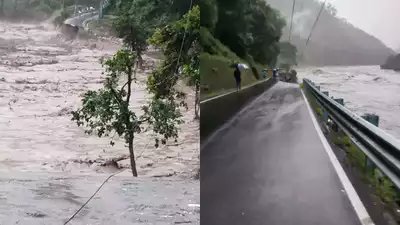latest updates on the catastrophic flash flood in Sikkim, with 14 lives lost and 120 still missing. Learn about the glacial lake outburst, infrastructure damage, and the ongoing rescue efforts in this unfolding tragedy.
In a tragic turn of events, the serene state of Sikkim woke up to a devastating flash flood on October 4, 2023, leaving behind a trail of destruction. At least 14 lives have been tragically lost, and the toll is expected to rise as rescue and recovery efforts continue. Furthermore, 120 individuals, including 23 army personnel, are still missing, causing deep concern among the authorities and residents alike.
Sikkim Flash Flood
Nature’s Fury Unleashed
The calamity was triggered by a glacial lake outburst following heavy rains in North Sikkim, resulting in a torrential flash flood. This event sent shockwaves throughout the region, claiming lives and wreaking havoc on vital infrastructure.
The Glacial Lake Outburst Flood (GLOF) primarily affected portions of Lhonak Lake in the Mangan district, where rising water levels surged downstream along the Teesta River Basin with alarming velocity. This catastrophic event has left a profound impact on several districts, including Mangan, Gangtok, Pakyong, and Namchi.
One of the most significant casualties of this disaster was the Teesta – III dam at Chunthang, which was completely washed away. Additionally, six vital bridges were swept away by the raging floodwaters, and the National Highway 10 (NH10) suffered extensive damage in multiple sections.
Is Climate Change a Culprit?
Meteorological data reveals that North Sikkim experienced approximately 39 mm of rain between Tuesday and Wednesday morning, creating the conditions conducive to this tragic event. Scientists suggest that the heavy rains possibly triggered an avalanche, which in turn led to the glacial lake outburst. The Lhonak glacier’s retreat over the years had caused the lake to grow in size, rendering it more vulnerable to such occurrences.
Government’s Response
The Sikkim government has been swift to respond to the crisis, mobilizing emergency services to the affected areas. Chief Minister Prem Singh Tamang (Golay) personally visited Singtam to assess the damages and engage with the local community, assuring that all possible measures would be taken to mitigate the suffering of the affected people.
The Unpredictable Torrent
According to the Central Water Commission (CWC), the flash flood occurred around midnight, with water levels rising rapidly at an alarming rate of 15 meters per second. By 6 a.m., the water level near Melli in the Teesta River was already 3 meters above the danger level, causing further concerns.
By 2:30 pm, the low-lying areas downstream from the Teesta River were flooded, exacerbating the damage. Thus far, different agencies have managed to rescue over 600 people, predominantly those living along the river or in close proximity to the highway.
Wide-Spread Destruction
The flood’s impact has been felt on several fronts. Four major bridges, a General Reserve Engineering Force (GREF) crusher plant, and hundreds of houses have been severely damaged. NH-10, a vital transportation artery, remains blocked at multiple locations. Additionally, there are reports of missing laborers at the GREF plant, further compounding the tragedy.
Multi-Agency Efforts
In response to the crisis, four National Disaster Reserve Force (NDRF) teams have been tirelessly working in Sikkim and neighboring areas along the banks of the Teesta River. Given that the Teesta River flows through four districts of West Bengal before reaching Bangladesh, a flood alert has also been issued for the northern districts of West Bengal and neighboring Bangladesh.
Neighborly Support
In neighboring West Bengal, a low-pressure system over Jharkhand and an associated cyclonic circulation have resulted in heavy rainfall. This has further exacerbated the flood-like situation in several districts, including Bankura, Howrah, Hooghly, West Midnapore, and South 24 Parganas. The state government has acted swiftly, establishing 190 shelter camps and evacuating over 500 people to safety.
As the residents of Sikkim and neighboring regions grapple with the aftermath of this devastating flash flood, it is a grim reminder of the unpredictable power of nature. The collective efforts of local authorities, rescue teams, and neighboring states are essential in providing support, relief, and hope to the affected communities as they begin the long journey toward recovery.
also read sikkim flash flood
